Dickinson College Student Exhibition Showcases Diverse Mediums, Styles

Photo by Carl Socolow '77.
Senior studio-art exhibition highlights wide-ranging student talents, styles
by MaryAlice Bitts-Jackson
Senior year is a time of intense productivity and self-discovery for studio-art majors. Throughout the year, they each amass a body of new work, meant to encapsulate all they’ve learned during their undergraduate years, for public viewing in the college’s art museum, The Trout Gallery. Along the way, they collaborate on all aspects of the exhibition: designing the gallery lighting and layout; selecting, preparing and installing the works; choosing wall color and text; writing and designing a catalogue of artists' statements. And after a trial run in the fall, they are ready to present their individual and combined artistic visions to the world.
In their artist’s statements, Elspeth Campbell, Kate Clements, Olivia Dwelley, Samantha Fonseca, Duanduan Hsieh-Song, Diane Lee, Nate Matlack, Lucy Paterson, Samantha Polinsky, Jingni Wang, Victoria Xiao and Adya Zecha explained the inspiration and methodology behind their capstone exhibition.
Elspeth Campbell
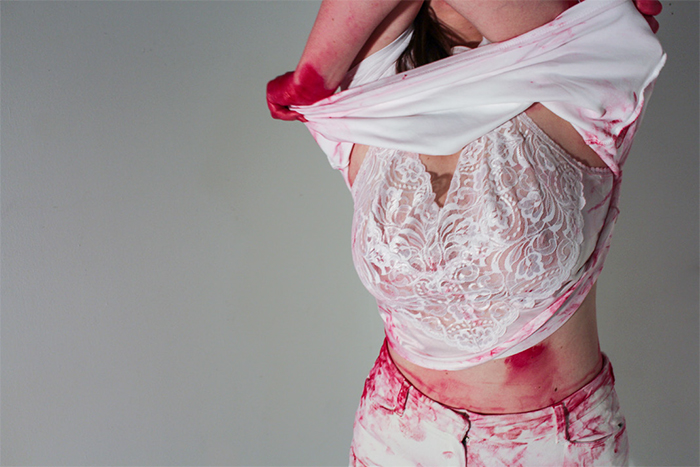
Elspeth Campbell, Cloth, 2019. Digital print, 8.5 x 11 in.
Campbell creates visceral paintings and drawings, often using unconventional materials like lipstick, and performance art documented in digital prints that explore difficult themes surrounding gender and lived experiences. “At its core I find performance art and the artifacts left from a completed piece to be highly evocative because the viewer imagines the feelings that the performer is experiencing, as well as bringing the audience to a perspective it might not otherwise have," she says. "This relationship between audience and artist is a powerful means to give voice to unheard and silenced perspectives.”
Kate Clements
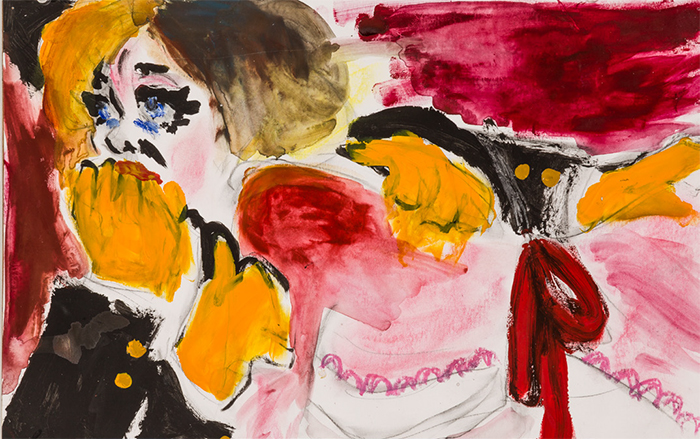
Kate Clements, Woman II, 2019. Acrylic on paper, 8.5 x 14 in.
Clements’ sculptures, collages, drawings and paintings depict “the sugar-coated nature of Southern culture and conduct” she draws from her childhood in a conservative, white Southern community. Many tap images of domesticity found in Midcentury magazine advertisements and illustrations. “I am interested in creating work that comments on the idea of covering bigotry in palatable guises,” she writes.
Olivia Dwelley
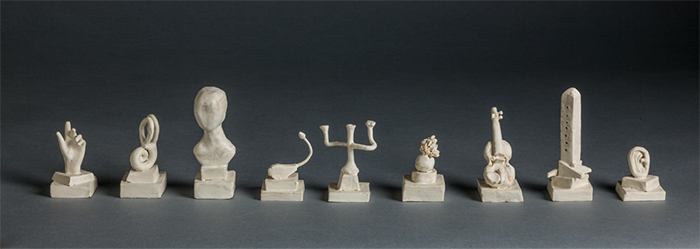
Olivia Dwelley, Pawn, 2019. Ceramic, 108 x 4.5 in.
Dwelley creates sculptures of parts of her body as a way of exploring ideas of identity and game-piece sculptures that represent pivotal biographical moments in her life. All are made out of the time-sensitive medium of clay.
Of the game piece sculptures, she writes: “All of these mementos have influenced who I am, from the straw hats that both of my grandfathers wore during the summer days to my fond memories of the warm lighting created by fires and low lamps during my time in Denmark. … These objects and experiences are remembered through the process of making each individual statuette.”
Samantha Fonseca
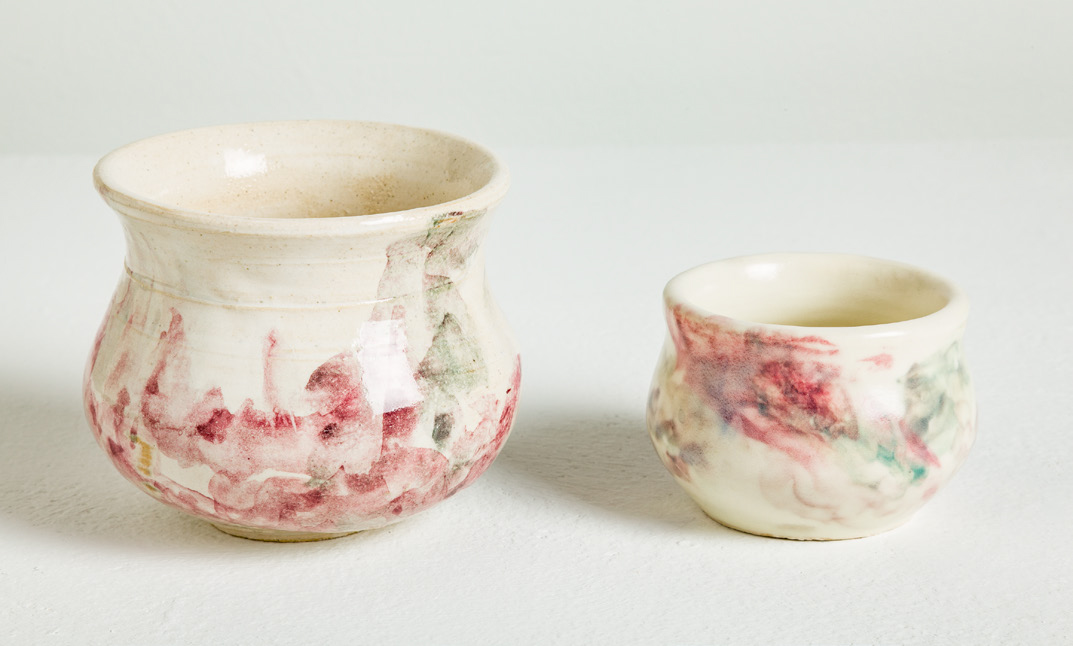
Samantha Fonesca, Naturale III, 2019. Ceramic, 7 x 5 x 3 in.
Fonseca combines two loves—watercolor painting and ceramics—in her delicately painted vessels, which are inspired by disposable clay cups she discovered in her native India, and by her interactions with friends. “My investigation into the disposability of chai cups in India propelled me to create unique vessels, with a hope that they will last for a long time and continue to be used throughout the owner’s lifetime,” says Fonseca, who did a performance piece about that practice earlier this year. By creating highly functional glazed vessels that could be used every day indefinitely, she simultaneously opens up a way to affirm relationships with friends and loved ones who may carry her artistic imprint wherever they go.
Duanduan Hsieh-Song
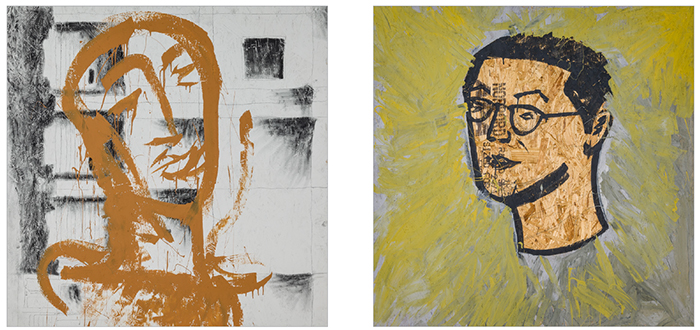
Two by Duanduan Hsieh-Song. Left: Yellow Man, 2019. Acrylic graphite charcoal on chipboard, 48 x 48 in. Right: Yellow Self-portrait, 2019. Acrylic graphite on chipboard 48 x 48 in.
Hsieh-Song, a Taiwanese-American who grew up in Taiwan and the United States, investigates the positive and negative aspects Asian-American identity, belonging, place and identity in painting, video, photography and digital media. His series includes self-portraits, illuminating his personal experiences as an Asian-American artist and works depicting racist symbols and imagery in contemporary American culture.
Some works are on chipboards—a material used on construction sites that, unlike the buildings being constructed, degrades over time. “By painting on chipboard, I’m granting the audience the opportunity to view the racial imagery that litters our history as a temporary artifact, a reminder that we, as multiracial Americans, can all participate in the construction of our current and future identity," he says. "Only by embracing our differences can we construct a strong American identity.”
Diane Lee
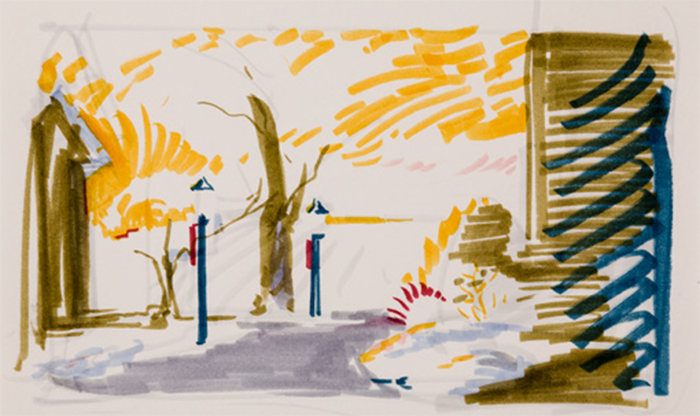
Diane Lee, Orbits, 2019. Oil on canvas, 24 x 20 in.
Lee, along with music major Sam Phelps ’19, is the recipient of the 2018-19 Weiss Prize for the Creative Arts, awarded annually to rising seniors who will create and present a new work to the college and local community. For her Weiss Prize presentation, Lee premiered an animated work, The Funeral. For her studio-art exhibition, she has been working in ink, charcoal and watercolor, as well as in digital realms, often combining words and imagery—all elements that, for her, are interconnected. “Such connections between different elements, which often become tangled and complicated, seem to imitate interactions between living beings,” she notes.
Nate Matlack
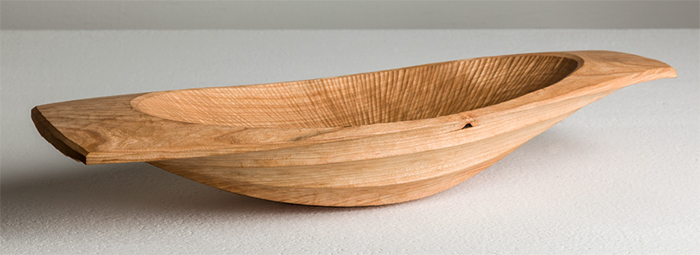
Nate Matlack, Cherry Bowl, 2019. Cherry, 16 x 16 in.
Inspired by observations he’s made in the great outdoors and by artful bronze animal sculptures collected by his grandfather, Matlack’s organic wooden sculptures echo a natural world that is continually in flux and often in motion. He also creates precisely crafted functional bowls that highlight the natural grain in the wood while calling to mind natural patterns such as those found in sand and in eroding rock. “The physicality of the process, the smell of the chips and the connection to the material that comes from working with green wood heightens the experience of creating each piece,” he explains.
Lucy Paterson
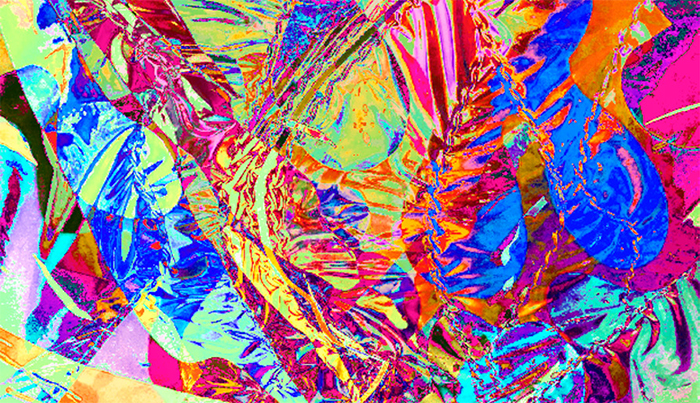
Lucy Paterson, No Words, 2019. Digital collage of personal drawings, paintings, fabrics, 8.5 x 11.
“I am fascinated with where the mind can take you—nothing is off-limits,” writes Paterson, who uses color, pattern and texture to explore dreams, daydreams and the subconscious, particularly with regard to ideas about optimism and fear of the unknown.
Samantha Polinsky
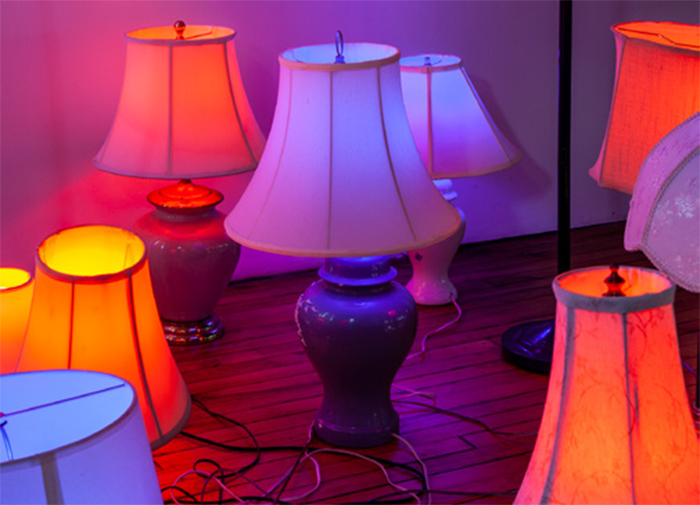
Samantha Polinsky, Anyone Got a Light? (detail), 2019. Lamps of various sizes.
Inspired by movies, television and internet videos as well as personal experiences, Polinsky uses a wide variety of materials—paper, paint, light, sound and found objects—to create sculptures and installations that explore particular spaces and humans’ interactions with spaces. She noes that by using light in her work, she adds “another layer of emotional intensity” to it, and that by combining light and sound, she’s able to engage multiple senses in addition to a sense of atmosphere she uses to transport the viewer. “I want people to feel they are exiting their own existence and entering the one I have created,” she explains.
Jingni Wang
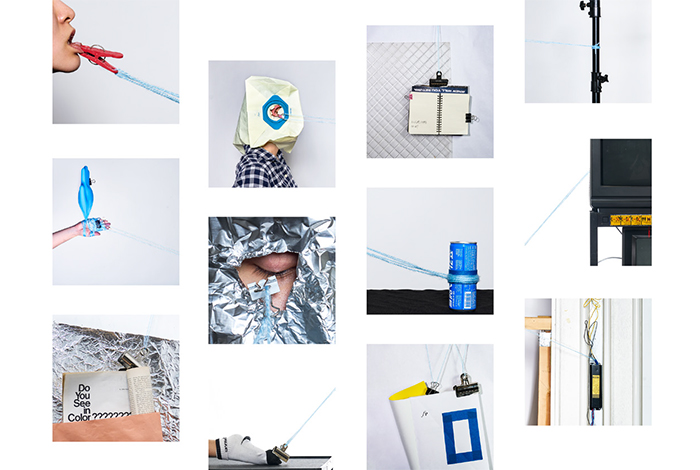
Jingni Wang, Autobiography (detail), 2018. Photograph, 70 x 45 in.
Wang uses long-exposure and multiple-exposure photography techniques to create photographs and video representing fragments of personal memories—often ambiguous and unreliable—that make up a whole memory and influence decisions and emotions. The relationships between memory, identity, learned values, destiny and desire are also explored. “Overvaluing memory is a dangerous move,” she notes, adding that she sometimes wonders how our responses might vary if we had no memories at all.
Victoria Xiao
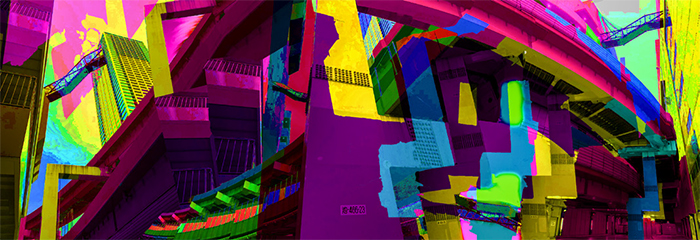
Victoria Xiao, 2049: Life, 2019. Digital photograph, 13 x 36 in
In vivid, foreboding urban skylines and energized street scenes, Xiao imagines a dystopian future informed by images from vintage Japanese animated works and by issues and phenomena endemic to city life. “Through layering photographs and taking images from different perspectives, I recreate the chaotic energy that large metropolises embody, and I bring the viewer into one of the parallel worlds of our future,” she writes. “These collages investigate the eeriness and displacement of possible dystopian futures that might occur if overpopulation, mass production and intrusive commercialization continue to expand.”
Adya Zecha
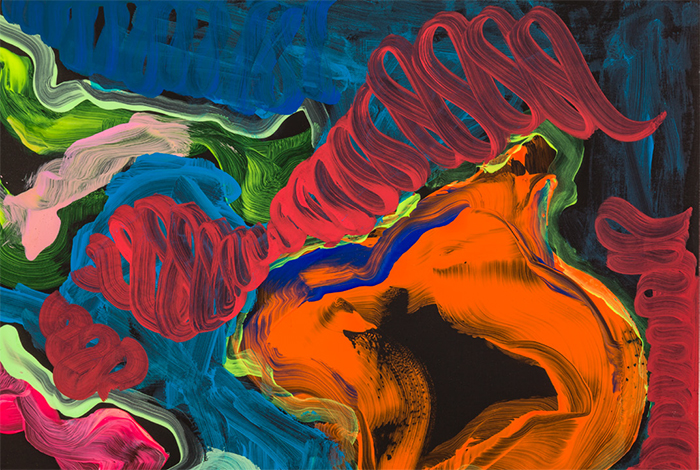
Adya Zecha, Teeth II, 2019. Acrylic marker, foam core, 24 x 18 in.
Saturated colors and intricate patterns evoke intense and unsettling internal experiences in Zecha’s works, which focus on the idea of meditation through, and depicted in, art. “The patterns progress into endless improvisations, lines working around previous shapes that adapt to the context,” she says.
TAKE THE NEXT STEPS
Published April 24, 2019